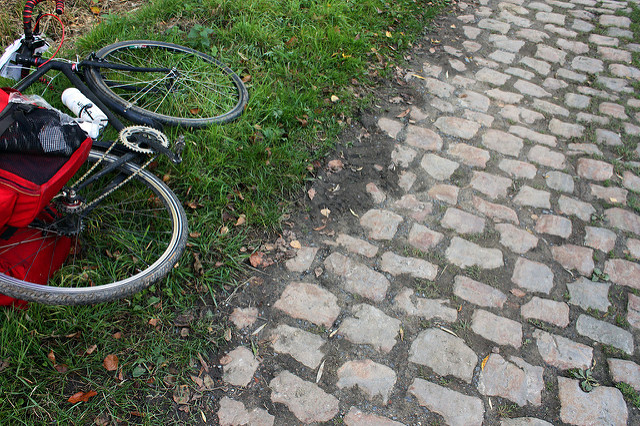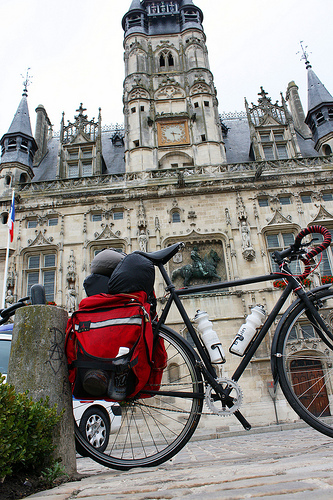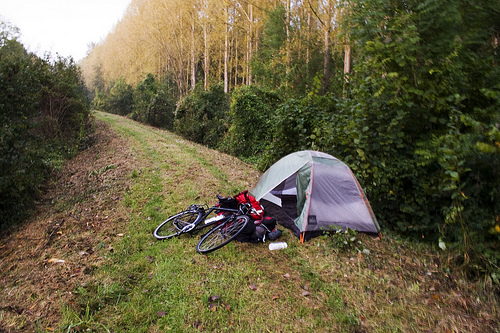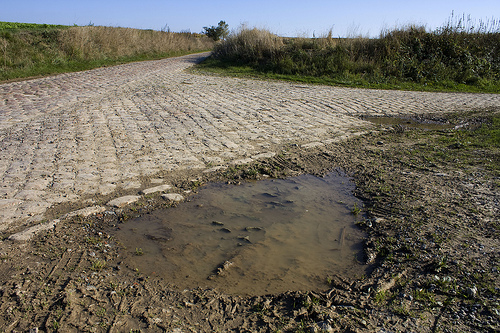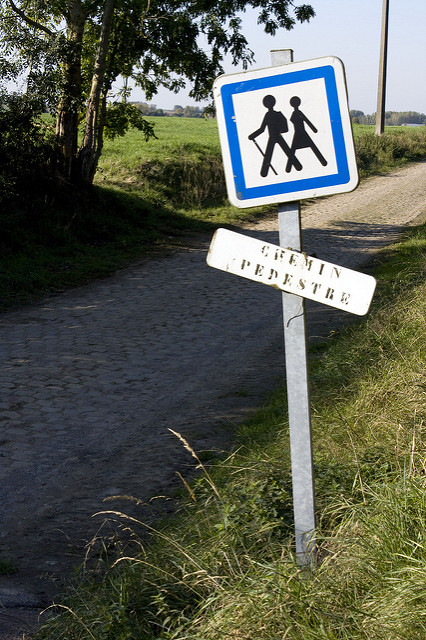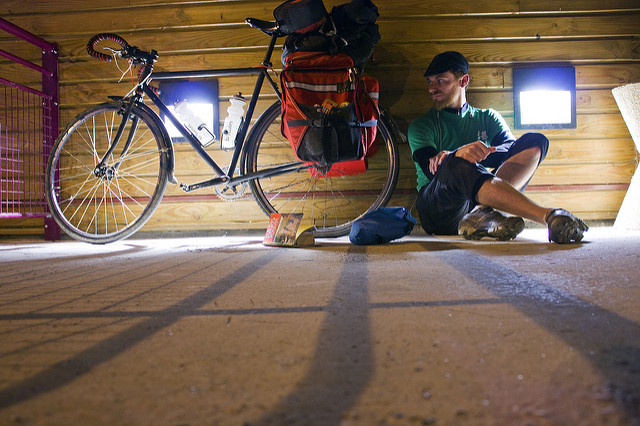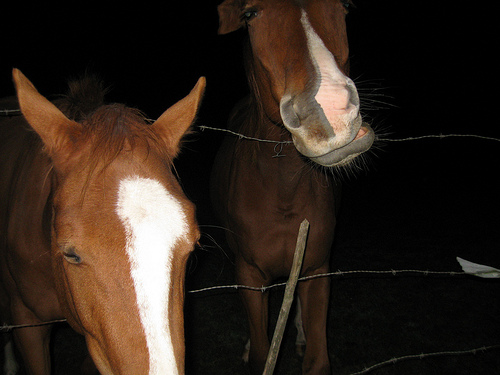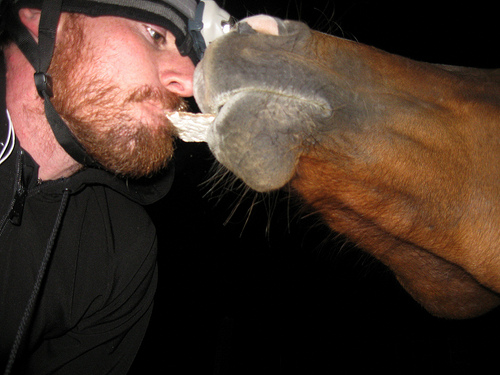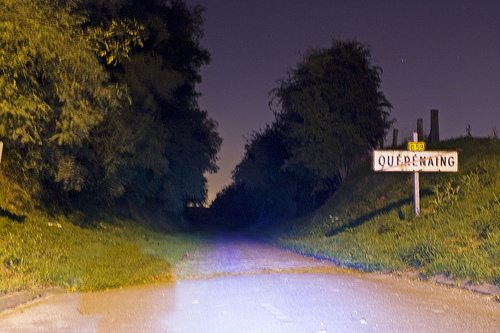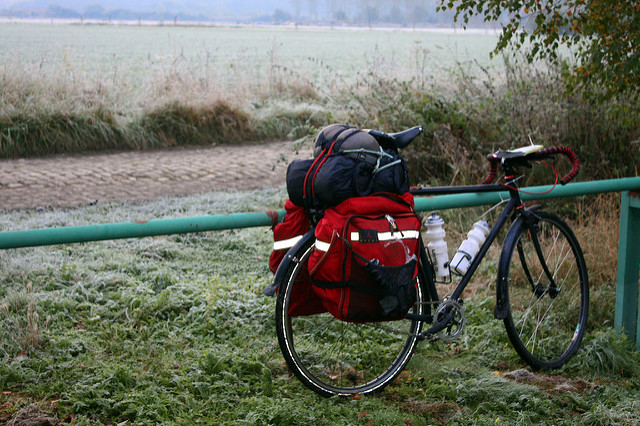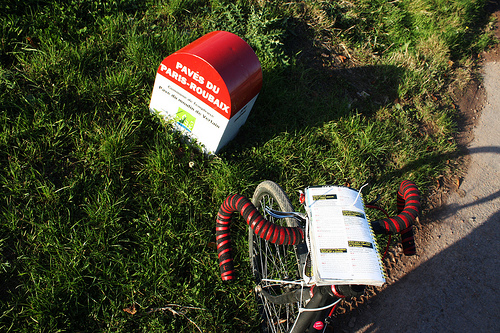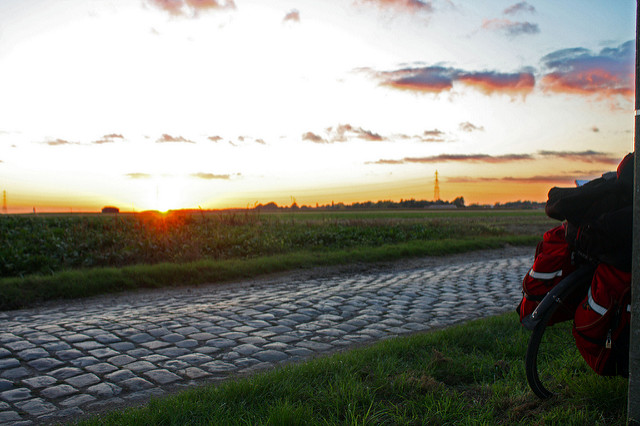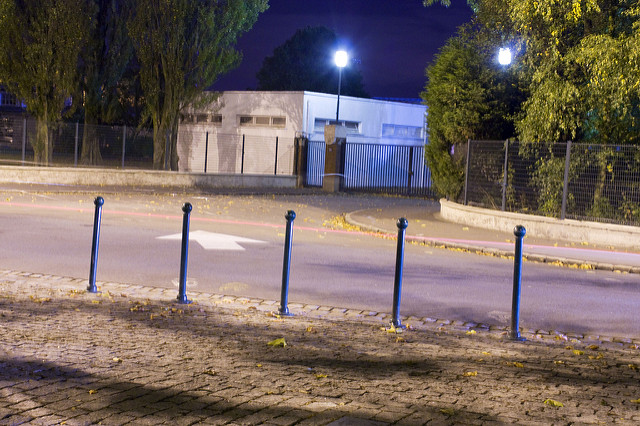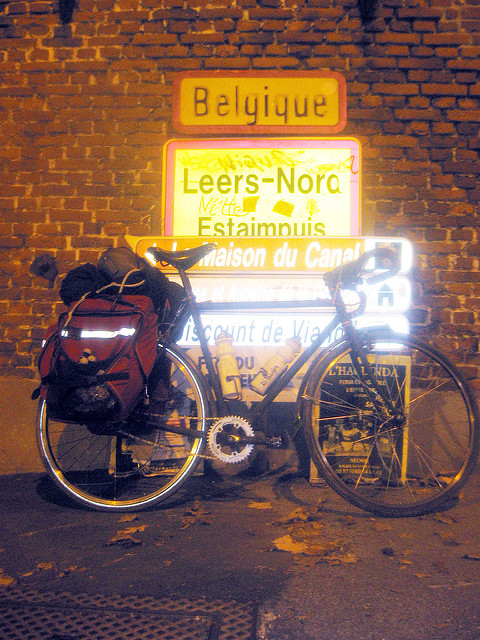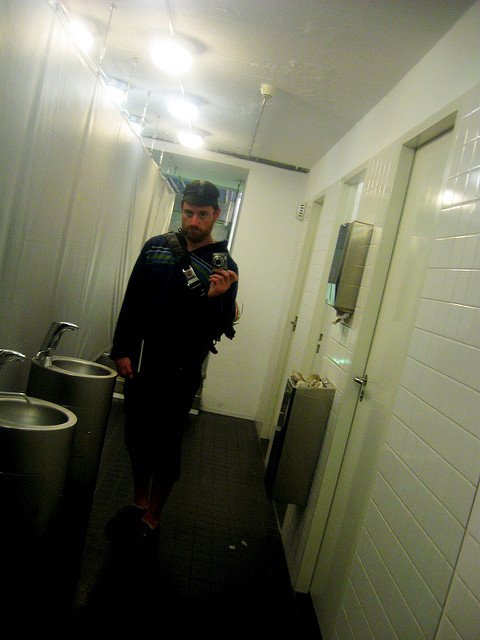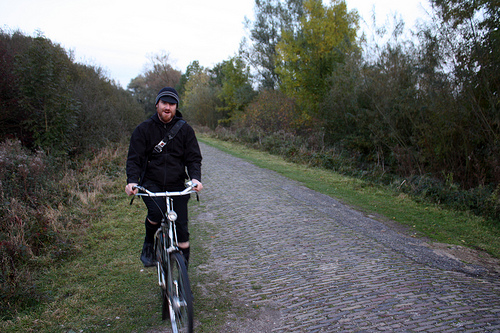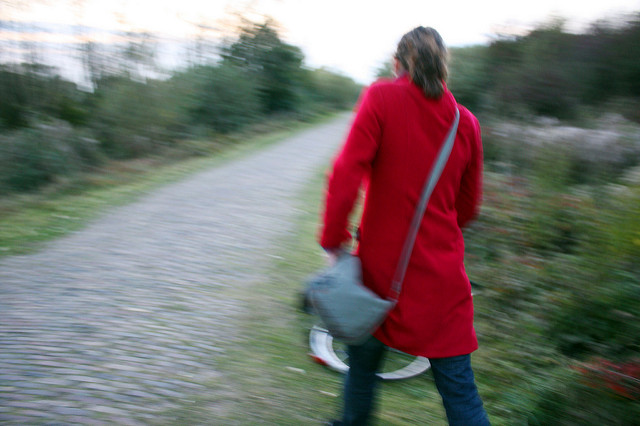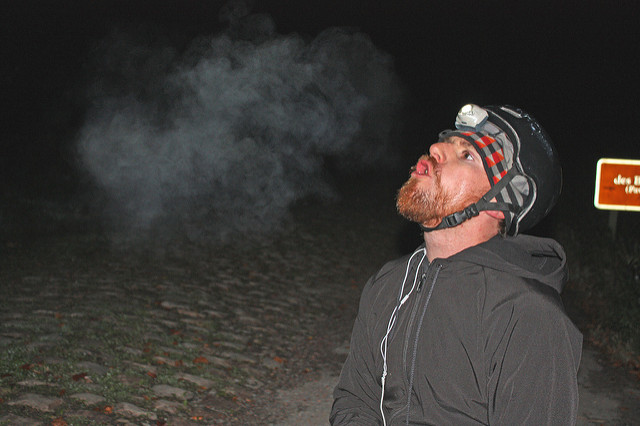
Secteur pavé #17 – la trouée d’Arenberg
This weekend is the Paris-Roubaix! One of my all-time favorite one-day races, if not for the fact that it was first raced in 1896 on Sunday, April 19th – or on Easter Sunday – no one really remembers… – and I was born a little over 100 years later on Sunday, April 19th, which was also an Easter Sunday. These types of coincidences should not be taken lightly. So, when I found myself living in Paris, wanting to visit friends in Amsterdam, I thought it best to visit the route used in the race.
Below is what I wrote in November of 2009, after I finished up successfully making it to Amsterdam in 5 days. Certainly not a speed run, but the route from Paris to Roubaix, by first cycling fairly straightforward to Compiègne and then following the route eats up almost 400 km itself. Then there’s the simple matter of passing through an entire country in a day and finally traveling the Netherlands to Amsterdam in the final. Totally ruled.
When I think of my Paris-Roubaix trip, I think of my future GDMBR/Tour Divide and my bid to race it. Like the essay below describes, it fits similar criteria:
- It’s literally, off the beaten path
- It’s not something I need to do
- I really have no true interest in the subject
The GDMBR, much like the Paris Roubaix pavé sections are similar as they both use less maintained, unimproved upon routes to to traverse over sections of land, with more civilized routes. In the GDMBR, we’re talking a patchwork of forest roads and jeep trails. For thousands of miles. As is obvious, these two routes are also very, very very different, since the North of France is quite different than traversing the Rocky Mountains. Still, finding and navigating through these sections is what gives both routes its interest.
I’ll also have to update my third criteria point: I really have no true interest in the subject and maybe an explanation:
I don’t really stay up all night dreaming of mountain biking and certainly not racing mountain bikes. I’ve come to the conclusion in my life that I’m a wanderer of sorts and right now, I’ve wandered into… ultra endurance mountain biking. I guess it happens – some people wander into learning how to ballroom dance or, I dunno, how to play a good game of chess.
To me, it’s the same thing. When I’m out on trails, training, I see other people as somehow more confident in their identity of “mountain biker”. They’re more confident in their equipment, how they ride – even in the setup of their cars/trucks to haul their bikes to/from the trail head. The clothes they wear… it’s all very subtle, but I lack much of what makes me solidify wanting to always commit and progress in this one vein of participation. I love too many things, too much.
And that is why if I identify with anything it is that of an artist and not a mountain biker or dare say – a competitive sportsman. Because I’m not. I’m just curious and I allow curiosity to take me everywhere. But, what I find exceptionally well, interesting are the mountains just to the west of where I live. I’m exceptionally interested in the conservation of wildlife and ecosystems, radical Monkey Wrench-type action against ill-advised and badly planned expansion or just enjoying learning what everything around me is, how it came to be and what will happen to it.
As I grow older, nature tugs at me and I yearn for a simple life, rather than a life filled with conveniences and technology. If that means living on run-down but seaworthy sailboat or moving to Alaska, it’s a safe bet that something like that will happen to me. I just need to find a mountain lady that likes to write and doesn’t mind my attempts at practicing drawing my chicken scratches – or something like that.
While taking part and experiencing the Tour Divide/GDMBR, I’m very much anticipating in the taking a sampling from end to end of this country of what is in my backyard: the Rocky Mountains – the good and the bad, from skirting amazing National Parks to seeing even more SuperFund sites (researching Denver’s SuperFund sites is a wondering way to became extremely depressed).
Although I think of myself as a sensitive person, nothing moves me to so much passion as learning about sensitive and extremely endangered areas, like the Flathead Valley in Alberta, Canada who some want to protect and conserve, while others want to exploit the nature resources of and well in the process basically destroy. The small but very moving video piece about the International League of Conservation Photographers performing a R.A.V.E. (Rapid Assessment Visual Expedition) of the area, highlighting some of the powerful reasons to conserve the area leaves me angry and in tears, not only because I know what I want (conservation) and feel powerless against the powers that be, but what these people are doing is exactly the type of things I’m completely capable of doing – and thus, not powerless:
I know how to wield a camera, I know how to illicit a thought-provoking image, to build narratives, I’ve got backcountry (limited as they are) skills and I know how to – you know, – work it. My hope is maybe racing this race will give me some strange sort of Street Cred. to be more of a force behind conservation efforts in places like the Flathead Valley.
Maybe, maybe not. Too much reading of Edward Abbey – maybe? If you can only help change one mind… One interesting idea about how to conserve areas is to get people out there and enjoying them – like my fellow racers and I will be in the Flathead Valley come June. The only reason I know about the area is because of this race. Consider the American National Park System. I may grumble quite a bit on a conga line up Longs Peak from time to time, but I’m so happy it’s there for anyone to use – for free. It’s incredible.
And maybe as a way to close this little foray into my spontaneous train of thought and back into Paris-Roubaix and to end the introduction of the below essay: the reason why there’s still crappy sections of pavé in Northern France is because of this race – because people felt that the tradition of a stupid bicycle race (culture, in other words), was more important than, “progress” which was growing all around the route anyways, from the multi-lane highways, to the nuclear power plants just a pavé-stone throw away from some of the secteurs…
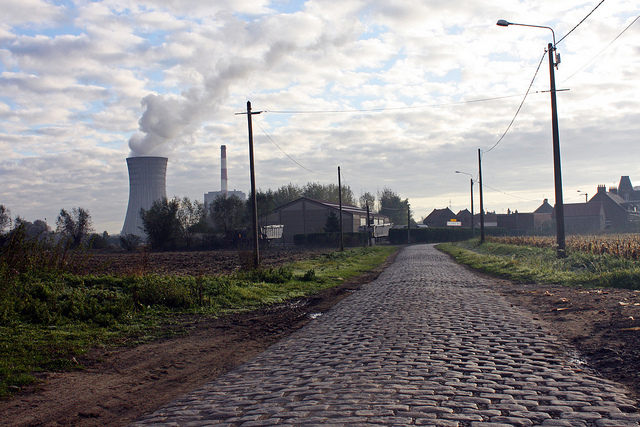
Secteur pavé #15: de Hornaing à Wandignies-Hamage
I hope you enjoy the below meanderings:
Sometimes I even find the decisions I make concerning the way I do things questionable.
So I’m hanging out in Paris. I have friends in Amsterdam. I email them, asking if I can come visit, they say, “Come ’round.” Perfect, since Paris is a hub of transportation options to get to somewhere like Amsterdam. The most obvious being by train – or even take a plane.
I take out a map, I go, “Hmm”… a little and say, “Well, I’ll ride a bicycle to Amsterdam, instead”. Knowing full well that it is now Fall and Fall means it’s cold and bicycle rides of such distances mean, for me, Camping Savauge. Camping Sauvage means simply exhausting oneself of functioning whilst riding a bicycle, to retire to finding a quiet, out of the way patch of secluded land to discretely lay a tent down and snore for a while.
You may also call it, being a complete bum.
And – that’s what you must look like: a bum. You’re on someone’s property, having your way with things, just sleeping as if the world doesn’t turn when you’re nodding off and then, you just get up, whenever you feel like and keeping on going. It sounds inherently dangerous, but, it isn’t. There are secrets, I guess to successful Camping Sauvage. We will not get into that, in this essay.
The day before I’m supposed to leave, I visit the local camping store. Stores. There’s many, as is la mode in Paris, where many different boutiques are established under the same name, since storefronts are just designed that way. I go to the pots ‘n pans, stove + fuel magasin for some fuel and the books ‘n maps magasin for a map of Northern France –
And what catches my eye? But a guide through the route of Paris-Roubaix!
To the uninitiated, Paris-Roubaix is a one-day professional bicycle race, known to be extremely difficult, since the race follows a route that tries, as hard as possible, to use the sketchiest, oldest cobblestone roads that can be found and is also known in the same circles as a complete joke, not even a race! – for the exact same reasons.
The cobblestone sections are now somewhat well maintained, since there’s just not that many any more to be used. A much different story, when the race was first ridden, over 110 years ago. What makes this all the more hard is that it’s raced on road bikes – $10,000+ carbon fiber super bikes (these days) and not mountain bikes, of any sort, which would make such terrain castrated.
I’m holding the guide in my hand and I decide to buy it. It sounds like a good adventure, since it fills many of the necessary requirements:
* It’s literally, off the beaten path
* It’s not something I need to do
* I really have no true interest in the subject
The last point needs some explanation.
I like bicycles. Quite a bit. I don’t really love bicycle racing. I’ve done a little bit of it myself, but it’s not a passion. I like roads too – but nothing really about cobblestones makes me get up in the morning, to start a new day.
What does spark my interest is having to search for something so benign – a road! A road that may be very old, that’s not used very much, that you need a guide, to even find!
The stretches of cobblestones in the Paris-Roubaix race are only dozens of kilometers long, under 50, I’d guess. The entire race is 260 km. What this means, is that what you’re looking for, isn’t even most of your ride – the cobblestone sections are split up in a few dozen (again, around 30) different sections. It means that there’s a lot of things to find and what you find is fairly diminutive.
It comes down to the act of the journey being the most important part, not what’s to be found. Like I constantly remind myself, there’s nothing I can do, to transport you the places I’ve seen and more importantly, the feelings I felt, while doing this course – and afterwards, to Amsterdam.
What follows, though, is a small photo essay on what I did find, as well as a few notes of my travels.
My ride for this adventure was going to be my trusty Surly Cross Check, known to me as, Marserena III. What makes this somewhat interesting is that the bike is not set up with multiple gears – I had basically just one. One is fine on a beach cruiser, but for touring, well, I’ve never done it before. Things get a little problematic when you face something like a hill. But going to Amsterdam, I really wasn’t expecting much of that, so – whatever.
When I was planning on writing this all out, I was going to emphasize the components being used, as single speed and fixed geared bicycles are certainly in style. Touring on such a beast, mostly used either on an actual vélodrome, or as city bike seemed to me, as quite the hipster thing to do – we could even coin the term Hipster Touring for such a setup, but we run into one impassible problem:
If you’re that much of a hipster to be touring with a single speed/fixed gear bike (fashionable bike, in other words), you wouldn’t have the interest in actually pursuing the tour at all, since there’s nothing really ironic about spending so much time to get something done. In the end, it’s just riding a bike, once again. End of story.
I left Paris on Tuesday, around 9:30…ish. Much later than I wanted to. I asked my ever-generous host, which way out of Paris and she told me to take, N17, which turns into D117, otherwise known as La Route de Flandre.
Basically translated to, “How to get to Belgium”
Since we’re on the subject of, “Roads”, one must think about the history of this little path, how/when it started and the changes it has gone through, since its inception.
The route, sucked.
Construction all the way to Compiègne – the contemporary start of Paris-Roubaix. Construction was partnered with fairly heavy traffic and modifications needed to my route, since the construction literally closed the road itself and I had to scramble to find alternative ways to get to Compiègne.
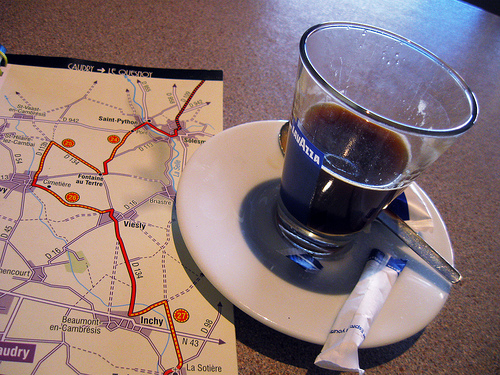
This is my guidebook. The sections of the route (red) that are dashed are the parts that are cobblestone. The time it took to finish the ride to Roubaix is quiet extended – as you can see from this page. The race route isn’t straight, it turns all over the place. It also doesn’t follow the main routes. This page shows just the start of the route – it gets worse, the closer you get to Roubaix. A good part of one day was spent in the same 10 square kilometers.
Hôtel de Ville, Compiègne. This is our starting line.
Even though I made it to Compiègne by the first day, and started the Paris-Roubaix route shortly after, I did not hit any pavé the first day.
To give you an idea on the speed I’m moving, I can generally cover 100 – 200km/day. 200km is sincerely pushing it, since there’s just so much sunlight, I’m on a bike that only has one gear and I’m packing some serious baggage. As well as the camping gear, clothes, toiletries, camping food/stove, I brought two cameras, many books (mostly French books) and a MacBook Pro.
Bum, indeed.
The route from Paris to Roubaix is over 320km. It took me three days to cover it – once I hit the Belgium border, I kept going.
From Roubaix, Amsterdam is another ~270km. I did this in two more days. This, of course, does not take in the countless times I got lost trying to find these small patches of cobbles.
So, I did about 100 miles/day for 5 consecutive days. If you map this route, you’ll find that it’s generally a lot less in distance than what I’m saying. Your mapping will not take into consideration the Paris-Roubaix route (twisting) and my wanderings (many).
Secteur pavé #26 de Quiévy à Saint-Python
Sectuer pavé #25
The guide I got was actually about walking the Paris-Roubaix route and doing so, in about nine days. I couldn’t imagine something more boring.
Taking a break from riding on Day #2. I was awaiting a pizza being baked in a van in a random parking lot, in a random town, near Secteur #21 in Verchain-Maugré. The pizza was OK and I kept riding, well after midnight – probably until 2:00 am, or so.
This would have been extremely dangerous, but the route followed small, local roads, with little or no traffic. The few larger roads I was forced on all seem to have bike lanes. Appreciated.
Funny things happen on the pavés during the night. This is relatively flat country and these are relatively unused roads. Sometimes, you find a car, parked on it, for what seems, no reason. I got up close to some of these cars, only to find two teenage heads bobbing up from the back seat. Cracked me up.
Horses near Secteur #20 in Quérenaing. Thought I’d try the, “I have some food in my mounth fake-out”

Secteur pavé #17 – la trouée d’Arenberg
The nights were very cold.
Secteur pavé #16 – de Wallers à pont Gibus, à Hélesmes
Camped right off of the pavé. Woke up very very cold. Notice the frost on the ground.
Secteur pavé #15: de Hornaing à Wandignies-Hamage
French towns next to nuclear power plants always seem excruciatingly depressing.
Secteur pavé #7

Secteur pavé #4 le carrefour de l’Arbre
Secteur pavé #3 de Gruson
Another short day was drawing to a close. Still, a few hours to the finish and well away from Amsterdam
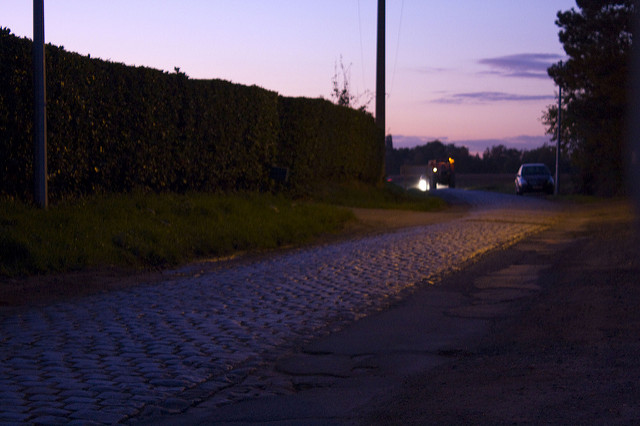
Secteur pavé #2 de Hem
Secteur pavé #1 Roubaix Espace Charles-Crupelandt
The last piece of pavé is actually in between the two sides of l’avenue Alfred Motte. That big arrow points to the entrance to the velodrome in Roubaix – the current finish of Paris-Roubaix. Being after 21:00, the velodrome was certainly not open, so that was the end of my little trek for Paris-Roubaix.
I still had the problem of getting to Amsterdam. In the next few days. And I mean days: two, at maximum. Pushing ahead.
What Belgium looks like, initially.
Belgium was somewhat of a blur – I didn’t take many pictures. It was somewhat forgettable. I sauvaged in a very small patch of wooded land, next to a cow pasture and, as I realized when light hit in the morning, someone’s back yard. Whoops. There’s not much free land left. Another depressing thought. Whatever really – another notch in the, “countries I’ve visited” headboard.
Amsterdam was reached around 22:30, on Saturday Night (I initially left on Tuesday, 930am). I stayed only till Monday and then off to the small city of Nijmegen.
You’d think that Amsterdam would be a perfect city to be a flâneur in – and you’d be right, but I never really got myself together to take too many pictures.
Actually, you may just want to give me (Maybe I mean, I may want to give myself) a break: I just spend three days searching for, and photographing, roads. Talk about the ultimate flâneurusation. In Amsterdam, I was more interested in hanging out with my friends and their child, resting and recovering from a marathon ride through some backwater towns and generally, well, eating. More pictures does not necessarily mean better. And, I’ll come back.
Autoportrait at the FOAM museum:
Well, the bathroom, anyways. Good exhibits. The joke is that it’s a photography museum and I have a photograph in it. Ha ha.
I traveled to Nijmegen after Amsterdam – this time, by train. I’m not comfortable taking trains anywhere yet – they seem like such a weird idea. It’s the American upbringing I guess. I went to Nijmegen to meet someone I met in New Zealand in the spring. She had some city bikes and we went for a bike ride through the countryside,
My Friend, and I
My Friend:

